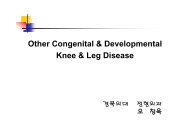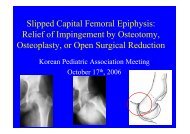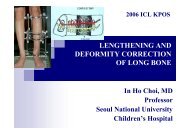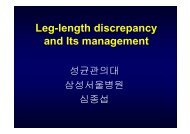Leg-length discrepancy
Leg-length discrepancy
Leg-length discrepancy
Create successful ePaper yourself
Turn your PDF publications into a flip-book with our unique Google optimized e-Paper software.
<strong>Leg</strong>-<strong>length</strong> <strong>discrepancy</strong><br />
and Its management<br />
성균관의대<br />
삼성서울병원<br />
심종섭
Etiology of Undergrowth<br />
• Congenital limb deficiency<br />
: congenital femoral deficiency,<br />
congenital fibular deficiency, tibial hemimelia<br />
• Asymmetrical neurological disorders<br />
<strong>Leg</strong>-<strong>length</strong> <strong>discrepancy</strong><br />
: hemiplegic CP, poliomyelitis, hemimyelomeningocele<br />
• Traumatic causes: malunion, growth plate arrest<br />
• Hemiatrophy: Idiopathic, Russel-Silver syndrome<br />
• Other causes: infection, tumor, post-irradiation,<br />
Blount’s disease, LCPD, unilateral clubfoot,<br />
congenital pseudarthrosis of the tibia
<strong>Leg</strong>-<strong>length</strong> <strong>discrepancy</strong><br />
Trauma sequelae residual poliomyelitis osteochondromatosis
Etiology of Overgrowth<br />
• Post-traumatic overgrowth<br />
:femur shaft fracture, tibia shaft fracture<br />
• Soft tissue overgrowth syndrome<br />
:gigantism with neurofibromatosis, Klippel-<br />
Trenaunay syndrome, Beckwith-Wiedemann<br />
syndrome, Proteus syndrome<br />
• Idiopathic hemihypertrophy<br />
• Chronic inflammatory arthritis (ex. RA)<br />
<strong>Leg</strong>-<strong>length</strong> <strong>discrepancy</strong>
Idiopathic<br />
hemihypertrophy<br />
Klippel-Trenaunay<br />
syndrome<br />
<strong>Leg</strong>-<strong>length</strong> <strong>discrepancy</strong><br />
Neurofibromatosis
<strong>Leg</strong>-<strong>length</strong> <strong>discrepancy</strong><br />
Mechanism of compensation<br />
• The child with LLD usually compensates<br />
better than the adult.<br />
• The child can compensate for minor<br />
degrees of LLD by walking on the toes of<br />
shot leg.<br />
• The adult seldom compensate that<br />
manner- tend to heel-toe gait: vaulting gait<br />
& excessive pelvic motion and tilt.
Effect in Gait cycle<br />
The amplitude of vertical pelvic motion is increased by LLD.<br />
<strong>Leg</strong>-<strong>length</strong> <strong>discrepancy</strong>
• Pelvic obliquity<br />
Hip - Effect<br />
• Relatively uncovered hip of long leg and<br />
increased coverage of the hip of the short<br />
leg.<br />
• Increased risk of DA of the long leg<br />
<strong>Leg</strong>-<strong>length</strong> <strong>discrepancy</strong>
Effect in the Hip Joint<br />
<strong>Leg</strong>-<strong>length</strong> <strong>discrepancy</strong><br />
Decreased in CE angle on the long leg side<br />
-- decreased in the load bearing area<br />
-- causes late degenerative arthritis.
Effect in the Spine<br />
• Low back pain and late degenerative arthritis:<br />
controversial<br />
• LLD- causes increased incidence of scoliosis<br />
• Severity of the problem<br />
-- related to the severity of LLD<br />
-- uncompensated or uncorrected<br />
-- onset of age<br />
<strong>Leg</strong>-<strong>length</strong> <strong>discrepancy</strong>
<strong>Leg</strong>-<strong>length</strong><br />
Patient Assessment-clinical<br />
1)<strong>Leg</strong>-<strong>length</strong><br />
-Apparent <strong>length</strong><br />
: from the umbilicus to the medial malleolus<br />
-Real <strong>length</strong><br />
: from the ASIS to the medial malleolus<br />
-Wood block test<br />
<strong>Leg</strong>-<strong>length</strong> <strong>discrepancy</strong>
<strong>Leg</strong>-<strong>length</strong> <strong>discrepancy</strong><br />
Apparent <strong>length</strong>(UMD) Real <strong>length</strong>(SMD)
Wood block test<br />
<strong>Leg</strong>-<strong>length</strong> <strong>discrepancy</strong>
<strong>Leg</strong>-<strong>length</strong><br />
Patient Assessment-clinical<br />
1) <strong>Leg</strong>-<strong>length</strong><br />
2) Pelvic obliquity<br />
3) Angular deformity of the Joint<br />
4) Joint instability<br />
<strong>Leg</strong>-<strong>length</strong> <strong>discrepancy</strong>
<strong>Leg</strong>-<strong>length</strong><br />
Radiological Assessment<br />
<strong>Leg</strong>-<strong>length</strong> <strong>discrepancy</strong><br />
1)Teleroentgenogram<br />
- Single exposure of both leg on a long film<br />
- Reveals angular deformity<br />
- Error of magnification<br />
- Best technique for small children
<strong>Leg</strong>-<strong>length</strong><br />
Radiological Assessment<br />
2) Orthoradiograph<br />
- Exposures each joints individually<br />
- Avoiding errors of magnification<br />
- multiple exposure<br />
<strong>Leg</strong>-<strong>length</strong> <strong>discrepancy</strong>
<strong>Leg</strong>-<strong>length</strong><br />
Radiological Assessment<br />
3) Scanogram<br />
- Moving film cassette<br />
- Avoid magnification<br />
- Cannot assess whole shape of leg<br />
<strong>Leg</strong>-<strong>length</strong> <strong>discrepancy</strong>
Computed<br />
Scan Digital Radiograph Scanogram<br />
<strong>Leg</strong>-<strong>length</strong> <strong>discrepancy</strong>
Estimation of skeletal maturity<br />
• Atlas<br />
• Sum of scores<br />
- Bone age -<br />
• Statistical combination of scores<br />
<strong>Leg</strong>-<strong>length</strong> <strong>discrepancy</strong>
Bone age<br />
-Atlas-<br />
• Greulich and Pyle atlas (1959)<br />
- Rapid interpretation<br />
<strong>Leg</strong>-<strong>length</strong> <strong>discrepancy</strong><br />
- Few changed in the hand during the critical time of<br />
puberty<br />
- 성장과정중 아이들마다 편차가 많다.<br />
- Interobserver error<br />
- Hand or Wrist 의 anomaly 있는 경우 측정이 어렵다.
<strong>Leg</strong>-<strong>length</strong> <strong>discrepancy</strong>
Bone age<br />
-Scoring system-<br />
• Tanner-Whitehouse method (1975)<br />
- similar to Greulich and Pyle atlas<br />
: using hand and wrist X-ray<br />
: using computerized mathematical method<br />
(using 20 landmarks in the hand and wrist<br />
– scoring system)<br />
- more cumbersome, time consuming.<br />
<strong>Leg</strong>-<strong>length</strong> <strong>discrepancy</strong>
<strong>Leg</strong>-<strong>length</strong> <strong>discrepancy</strong>
• 1999<br />
- 5400명의 16세까지 어린이대상<br />
- TW2 방법<br />
<strong>Leg</strong>-<strong>length</strong> <strong>discrepancy</strong>
Growth Calculation<br />
• The Arithmetic Method<br />
• The Growth Remaining Method<br />
• The Straight line Graph Method<br />
• The Multiplier method<br />
<strong>Leg</strong>-<strong>length</strong> <strong>discrepancy</strong>
The Arithmetic Method<br />
• Simple<br />
-growth calculation-<br />
• Chronological Age<br />
• Inaccurate<br />
<strong>Leg</strong>-<strong>length</strong> <strong>discrepancy</strong>
The Growth Remaining Method<br />
• Skeletal age<br />
• More accurate<br />
-growth calculation-<br />
<strong>Leg</strong>-<strong>length</strong> <strong>discrepancy</strong><br />
Green and Anderson growth remaining graph<br />
(Green & Anderson,1963)
The Straight line Graph Method<br />
• Skeletal age<br />
• Accurate<br />
-growth calculation-<br />
• At least 3 check points needed<br />
<strong>Leg</strong>-<strong>length</strong> <strong>discrepancy</strong>
The Multiplier method<br />
(Paley et al, 2000)<br />
-growth calculation-<br />
<strong>Leg</strong>-<strong>length</strong> <strong>discrepancy</strong><br />
• Based on Green and Anderson’s growth<br />
Graph<br />
• 한두번의 측정으로도 비교적 정확하게 향<br />
후 예상
Lowerlimb multiplier for boys and girls<br />
<strong>Leg</strong>-<strong>length</strong> <strong>discrepancy</strong>
Multiplier method<br />
• Congenital Limb-Length Discrepancy<br />
∆m =∆ x M<br />
(∆: Current Limb-<strong>length</strong> <strong>discrepancy</strong><br />
∆m: Limb <strong>discrepancy</strong> at skeletal maturity)<br />
<strong>Leg</strong>-<strong>length</strong> <strong>discrepancy</strong><br />
Example) 현재 4cm 차이 있는 Congenital hemihypertrophy<br />
10세 남아의 최종 길이차이는 ?<br />
4 x 1.310 = 5.24 cm
• Developmental LLD<br />
∆m = ∆ + (IXG)<br />
I=1-(S-S’)/(L-L’)<br />
G=L(M-1)<br />
G= amount of growth remaining<br />
I=amount of growth inhibition<br />
L= current <strong>length</strong> of long limb<br />
L’=<strong>length</strong> of long limb as measured on previous radiographs<br />
Lm=<strong>length</strong> of femur or tibia at skeletal maturity<br />
M=multiplier<br />
S= current <strong>length</strong> of short limb<br />
S’=<strong>length</strong> of short limb as measured on previous radiographs<br />
∆ = current limb-<strong>length</strong> <strong>discrepancy</strong><br />
∆m=limb <strong>length</strong> <strong>discrepancy</strong> at skeletal maturity<br />
<strong>Leg</strong>-<strong>length</strong> <strong>discrepancy</strong>
• Right femur epiphyseal infection 을 앓은<br />
병력이 있는 10세 남아로 LLD를 주소로 내<br />
원하였다. 최종 예상 LLD는 ?<br />
8세 10세<br />
Femur <strong>length</strong>(cm)<br />
right 24 26<br />
left 26 29<br />
<strong>Leg</strong>-<strong>length</strong> <strong>discrepancy</strong><br />
I =1-(26-24/29-26) = 1-2/3 = 0.33<br />
G= 29(1.310-1) = 29 x 0.310 = 8.99<br />
∆m = 3 + (0.33 x 8.99) = 3 + 2.97 = 5.97 cm
Time of Epiphysiodesis<br />
• Lm = L x M<br />
• Lε = Lm – Gε<br />
• Mε=Lm/Lε<br />
L= current <strong>length</strong> of long limb<br />
M=multiplier<br />
Lm= <strong>length</strong> of femur or tibia at skeletal maturity<br />
ε = desired correction following epiphysiodesis<br />
Gε=amount of femoral or tibial growth remaining at age of<br />
epiphysiodesis(Gε= ε/0.71 for femur and ε/0.57 for tibia)<br />
Lε=desired <strong>length</strong> of bone to undergo epiphysiodesis at time of<br />
epiphysiodesis<br />
Mε=multiplier at age of epiphysiodesis<br />
<strong>Leg</strong>-<strong>length</strong> <strong>discrepancy</strong>
• Right distal femur epiphyseal infection 을 앓은 병력이 있는<br />
10세 남아로 LLD를 주소로 내원하였다. 가장 적절한<br />
epiphysiodesis 시기는 ?<br />
8세 10세<br />
Femur <strong>length</strong>(cm)<br />
right 24 26<br />
left 26 29<br />
Lm = L(29) X M(1.31) = 37.99<br />
Lε = Lm(37.99 ) – Gε(3/0.71) =37.99-4.22 = 33.77<br />
Mε=Lm(37.99)/Lε(33.77) =1.125<br />
multiplier chart 보면<br />
1.13 13세<br />
1.10 13세6개월<br />
따라서 가장 적절한 시기는 13세 1개월에 해당함.<br />
<strong>Leg</strong>-<strong>length</strong> <strong>discrepancy</strong>
Treatment<br />
• General Principles<br />
0-2cm: No treatment<br />
2-6cm: Shoe lift,epiphyiodesis,shortening<br />
4-20cm: Lengthening<br />
>20cm: Prosthetic fitting<br />
<strong>Leg</strong>-<strong>length</strong> <strong>discrepancy</strong>
Shoe lift<br />
• Patient who do not wish or are not<br />
appropriate for surgery.<br />
• Lift higher than 5 cm poorly tolerated.<br />
<strong>Leg</strong>-<strong>length</strong> <strong>discrepancy</strong>
Prosthetic fitting<br />
<strong>Leg</strong>-<strong>length</strong> <strong>discrepancy</strong><br />
• Significant discrepancies, deformed<br />
functionally useless feet<br />
• Discrepancies greater than 15-20cm and<br />
femoral <strong>length</strong> less than 50%<br />
• Fibular hemimelia with unstable ankle<br />
• PFFD: A/K prosthesis or BK prosthesis<br />
with Van Nes rotationplasty<br />
• Optimal age: syme amputation- end of 1yr<br />
Rotationplasty: 3 yr
Epiphysiodesis<br />
• Very low morbidity and complication rate.<br />
• Slowing growth rate of long leg and allowing<br />
short leg to catch up.<br />
<strong>Leg</strong>-<strong>length</strong> <strong>discrepancy</strong><br />
• Suitable for sufficient data to enable a confident<br />
prediction of <strong>discrepancy</strong> at maturity.<br />
• Tibial epiphysiodesis should be accompanied by<br />
arrest of proximal fibular physis if tibial<br />
shortening is greater than 2.5cm.
Epiphysiodesis<br />
• Phemister technique<br />
(JBJS,1933)<br />
<strong>Leg</strong>-<strong>length</strong> <strong>discrepancy</strong>
Epiphysiodesis<br />
• Blount (staple) technique (CORR,1949)<br />
<strong>Leg</strong>-<strong>length</strong> <strong>discrepancy</strong><br />
12yr/female 1yr 2yr
Epiphysiodesis<br />
• Percutaneous technique<br />
(Bowen R, et al,CORR,1984)<br />
<strong>Leg</strong>-<strong>length</strong> <strong>discrepancy</strong>
Male/14yr (Sk.age), LLD: 2.5.cm<br />
Idiopathic hemihypertrophy<br />
<strong>Leg</strong>-<strong>length</strong> <strong>discrepancy</strong>
Male/14yr<br />
<strong>Leg</strong>-<strong>length</strong> <strong>discrepancy</strong><br />
Proximal tibia & Distal femur epiphysiodesis, Lt
Postop 3 yr<br />
<strong>Leg</strong>-<strong>length</strong> <strong>discrepancy</strong>
Male/14yr<br />
Polyostotic fibrous dysplasia<br />
Tibial overgrowth, 2cm, right<br />
<strong>Leg</strong>-<strong>length</strong> <strong>discrepancy</strong><br />
Postop 3 yr
Epiphysiodesis<br />
• PETS(Percutaneous Epiphysiodesis using<br />
Transepiphyseal Screws)<br />
(Metaizeau JP, et al, JPO,1998)<br />
<strong>Leg</strong>-<strong>length</strong> <strong>discrepancy</strong>
8-plated growth plate<br />
Epiphysiodesis<br />
Stevens P, et al. JPO, 2006, 2008<br />
<strong>Leg</strong>-<strong>length</strong> <strong>discrepancy</strong>
Problems of Epiphysiodesis<br />
• Undercorrection<br />
-- growth or angulation<br />
• Overcorrection<br />
-- growth or angulation<br />
• Rebound phenomenon (staples or screws)<br />
• Failure of growth restoration<br />
• Staple breakage or bending<br />
<strong>Leg</strong>-<strong>length</strong> <strong>discrepancy</strong>
Shortening operation<br />
• Mature patient<br />
• Tibia< 4cm, Femur< 5cm<br />
<strong>Leg</strong>-<strong>length</strong> <strong>discrepancy</strong><br />
• Neurovascular complication is higher in<br />
tibia, fasciotomy is advisable.
Neurofibromatosis, F/16 yr<br />
<strong>Leg</strong>-<strong>length</strong> <strong>discrepancy</strong><br />
LLD, 4cm<br />
Genu valgum,Lt
Femur<br />
Corrective osteotomy<br />
1cm shortening<br />
<strong>Leg</strong>-<strong>length</strong> <strong>discrepancy</strong><br />
Tibia<br />
3cm shortening
Preop Postop 2yr<br />
<strong>Leg</strong>-<strong>length</strong> <strong>discrepancy</strong>
Growth stimulation<br />
• Circumferential release of periosteum<br />
• Foreign material implanted next to growth plate<br />
• Sympathectomy<br />
• Surgical constructed AV fistula<br />
• Periosteal stripping<br />
<strong>Leg</strong>-<strong>length</strong> <strong>discrepancy</strong><br />
-- none has been successful enough to be<br />
clinically useful.
Limb <strong>length</strong>ening operation<br />
• Codvilla(1905) – first described limb <strong>length</strong>ening<br />
• Compere & Sofield (1936)<br />
• Anderson (1952)<br />
• Wagner (1978)<br />
• De Bastiani (1986)<br />
• Ilizarov (1989)<br />
<strong>Leg</strong>-<strong>length</strong> <strong>discrepancy</strong>
• Transiliac<br />
One stage <strong>length</strong>ening<br />
- Shortening < 3cm<br />
- Acetabular dysplasia<br />
• Femoral and Tibial<br />
<strong>Leg</strong>-<strong>length</strong> <strong>discrepancy</strong><br />
Complication<br />
-Nerve injury<br />
-Artery occlusion<br />
-Reflex sympathetic dystrophy<br />
-Intraop. fracture<br />
-Joint stiffness or subluxation
Distraction Epiphysiolysis<br />
• Chonodrodiastasis (Gelbke,1951, De Bastiani,1986)<br />
- Separation of the epiphyseal plate<br />
- Immature patient<br />
- Risk of septic arthritis<br />
- Painful stiffness of the joint<br />
- Premature closure of the physis<br />
<strong>Leg</strong>-<strong>length</strong> <strong>discrepancy</strong>
Gradual <strong>length</strong>ening<br />
- Distraction Osteogenesis-<br />
• Ilizarov technique<br />
1) Corticotomy: preserve endosteal & periosteal<br />
blood supply<br />
2) Ilizarov Ring fixator: permit micro-axial motion<br />
3) Latency period: 7-14 days<br />
4) Proper rate & rhythm: 0.25mm x4 / day<br />
5) Encourage joint motion<br />
<strong>Leg</strong>-<strong>length</strong> <strong>discrepancy</strong>
Gradual <strong>length</strong>ening<br />
<strong>Leg</strong>-<strong>length</strong> <strong>discrepancy</strong><br />
• Device for gradual <strong>length</strong>ening<br />
- Unilateral fixator<br />
- Circular ring fixator (Ilizarov, Taylor spatial frame )<br />
- Combined internal and external fixation<br />
(Lengthening over IM Nailing)<br />
(Lengthening with submscular plate)<br />
- Totally implantable <strong>length</strong>ening device<br />
Albizzia nail<br />
ISKD<br />
Fitbone
Ring fixator<br />
Correction of complex deformity<br />
(as well as <strong>length</strong>ening)<br />
<strong>Leg</strong>-<strong>length</strong> <strong>discrepancy</strong><br />
Ilizarov Taylor spatial frame
Combined Internal and external fixation<br />
(Lengthening Over Nail)<br />
<strong>Leg</strong>-<strong>length</strong> <strong>discrepancy</strong><br />
• Shorten the period of external fixation<br />
• Reducing the rate of regenerate bone fracture
<strong>Leg</strong>-<strong>length</strong> <strong>discrepancy</strong><br />
Combined Internal and external fixation<br />
(submuscular plating after distraction osteogenesis)<br />
Oh, CW et al. JBJS Br 2009 :91: 1394-9<br />
Oh, CW et al. JPO B 2008 17: 265-9
Gradual <strong>length</strong>ening<br />
- totally implantable <strong>length</strong>ening device-<br />
ISKD Fitbone<br />
<strong>Leg</strong>-<strong>length</strong> <strong>discrepancy</strong>
Gradual <strong>length</strong>ening<br />
• Complication of gradual <strong>length</strong>ening<br />
: 14%-134%<br />
Untoward Events - Paley D,CORR,1990<br />
<strong>Leg</strong>-<strong>length</strong> <strong>discrepancy</strong><br />
- Problems - not requiring operative intervention to resolve<br />
- Obstacles - requiring operative intervention but without<br />
permanent sequelae<br />
- Complications - intraoperative injury or anything resulting<br />
in permanent sequelae
Thank you<br />
for your attention !
Thank you<br />
for your attention !






